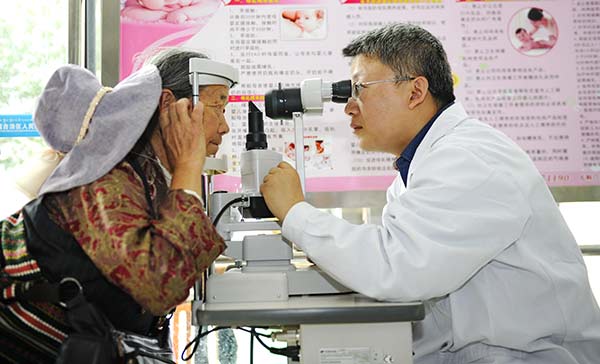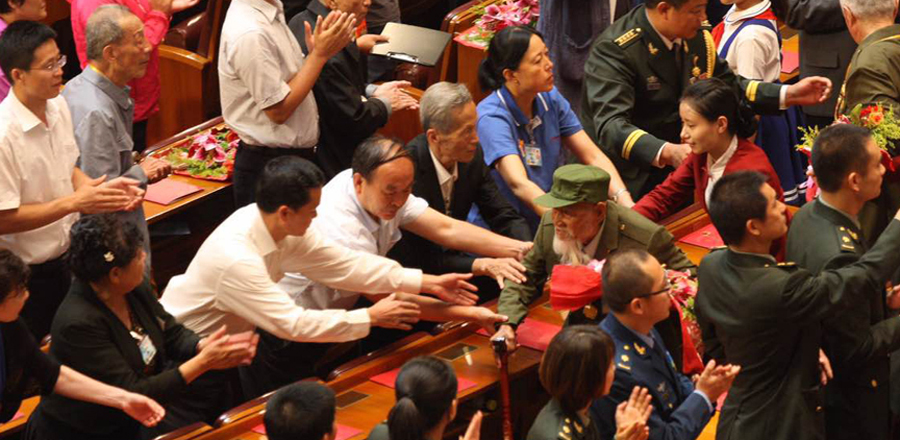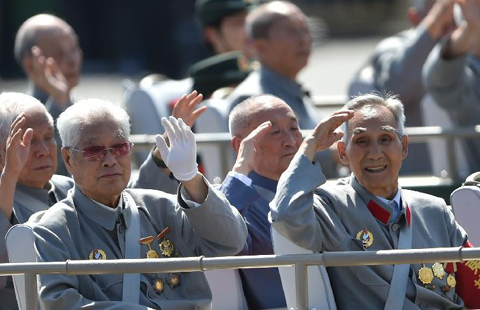Mothers, babies safer and healthier
Updated: 2015-09-05 08:38
By Palden Nyima and Da Qiong in Lhasa, Tibet(China Daily)
|
||||||||
 |
|
A volunteer doctor from Shandong province conducts an eye examination for a woman in Lhasa, the Tibet autonomous region. Zhang Rufeng / Xinhua |
Traditionally, women have chosen to give birth at home in the Tibet autonomous region, which caused dramatic death rates for mothers and newborn babies. But improved maternal care has reversed the trend, Tibet's Women's Federation said.
Over 50 years, thanks to investments from the central government, the All-China Women's Federation and many organizations, the maternal and infant mortality rates have decreased sharply in the region.
Statistics from the regional women's federation released on Wednesday show that the maternal mortality rate has dropped to 108 per 100,000 from about 5,000 per 100,000 five decades ago. In the same period, the infant mortality rate has decreased to 16.8 per 1,000 from 430 per 1,000.
Behind the trend are improved obstetrics and a growing acceptance of hospital births. Tibet's health authority said 82 percent of women chose hospital births in the first half of 2014.
Government investment has funded the construction of medical centers in remote areas, bringing healthcare closer to rural residents.
"Tibetan women are now reimbursed all of their hospital fees, and most women now choose hospital delivery," said Drolma Yangkyi, a medical worker at Lhasa's Maternal and Children's Hospital.
Healthcare and hygiene has improved, and women now account for 70 percent of staff at all levels of medical agencies across Tibet, Tibet's Women's Federation said.
Education has also improved. The current primary school enrollment rate is 99.6 percent overall, with the female enrollment rate at 99.6 percent. The junior middle school enrollment rate is 98.9 percent, with 99.8 percent for females, the women's federation data show.
With the support of the Tibet Women's Federation, the Tibet Water Resource Department, and others, more than 20 million yuan ($3.15 million) has been invested in more than 100 townships.
The money was used to build wells, as well as paying for courses and schools for poorer female students, and vocational training courses.
Contact the writer at palden_nyima@chinadaily.com.cn
- Three killed, 8 missing after fishing boat capsizing in S.Korea
- Migration crisis tears at EU's cohesion and tarnishes its image
- Britain signals move towards air strikes in Syria
- Snowden accepts Norwegian prize via video link
- Tokyo ditches Olympic logo amid new plagiarism allegation
- Japan criticized for protest over UN chief's visit to Beijing

 50th anniversary of Tibet autonomous region
50th anniversary of Tibet autonomous region
 Red carpet looks at the 72nd Venice Film Festival
Red carpet looks at the 72nd Venice Film Festival
 China beats Russia in 4 sets at volleyball World Cup
China beats Russia in 4 sets at volleyball World Cup
 8th Int'l Military Music Festival 'Spasskaya Tower' begins
8th Int'l Military Music Festival 'Spasskaya Tower' begins
 Downpour floods streets in Beijing
Downpour floods streets in Beijing
 Veterans attend V-Day anniversary gala show
Veterans attend V-Day anniversary gala show
 Military helicopters write number 70 high in the sky
Military helicopters write number 70 high in the sky
 Salute to veterans
Salute to veterans
Most Viewed
Editor's Picks

|

|

|

|

|

|
Today's Top News
Austria, Germany open borders to migrants
Central government steps up economic support for Tibet
China economy enters 'new normal' eyeing 7% growth rate: G20
Troop cuts signal path of peaceful development
Sino-Russian investment fund eyes more deals
Predicting Internet's future without a crystal ball
Silk Road Fund to expand ties with lenders
Intl community echoes Xi's speech at V-Day commemoration
US Weekly

|

|








